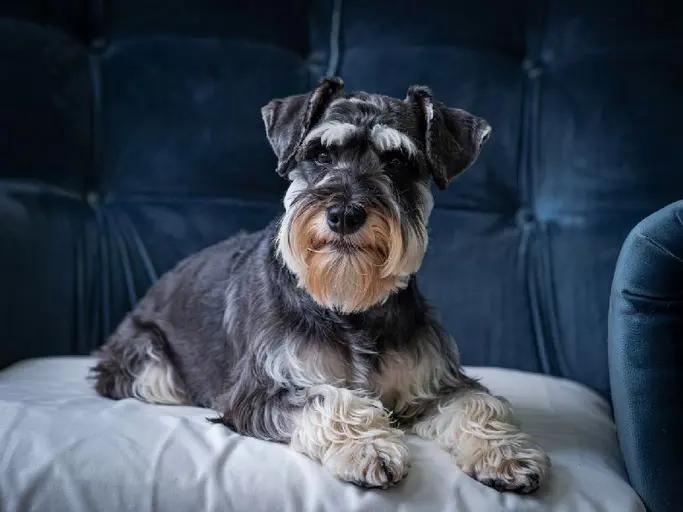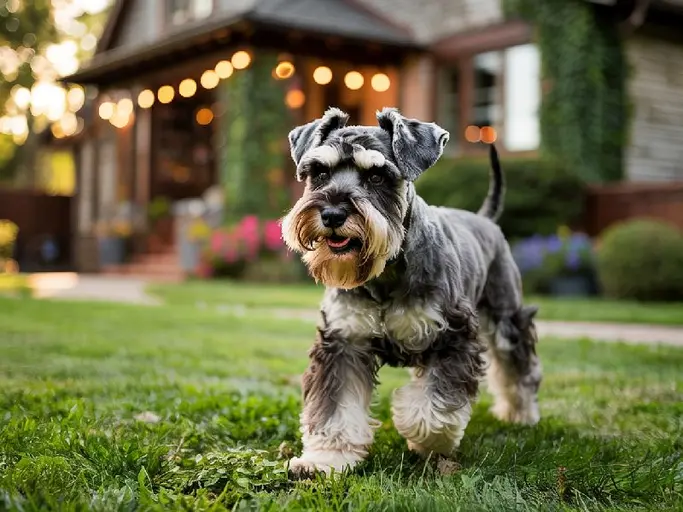The Miniature Schnauzer: A Complete Guide to This Charming Breed

Brief Introduction
The Miniature Schnauzer is a small, sturdy dog with a big personality. Instantly recognizable by its distinctive beard and eyebrows, this breed is known for its intelligence, energy, and devoted nature. Miniature Schnauzers are more than just a pretty face; they’re smart, adaptable companions that thrive on interaction and engagement. What makes them so attractive? Their manageable size, relatively low shedding, and spirited yet trainable temperament make them a popular choice for families, singles, and seniors alike. They’re the smallest of the three Schnauzer breeds (Standard and Giant being the others), but they pack all the characteristic Schnauzer traits into a compact package.
Breed History
The Miniature Schnauzer’s history is rooted in 19th-century Germany. While the Standard Schnauzer was already established as a versatile farm dog, the Miniature Schnauzer was developed to create a smaller, equally capable ratter.
Origins in the German Farmlands
Bred down from the Standard Schnauzer, using affenpinschers and possibly miniature pinschers to reduce the size, the Miniature Schnauzer emerged as a breed in its own right around the turn of the 20th century. These smaller dogs were perfectly suited for controlling rodents in barns and stables, keeping the farms pest-free. Their wiry coat provided protection from the elements and the bites of vermin.
Recognition and Refinement
The breed was first recognized by the German Kennel Club in 1899. Breeders focused on maintaining the desired temperament and physical characteristics while solidifying the miniature size. They arrived in the United States in the 1920s and quickly gained popularity as beloved family pets due to their adaptable nature and charming personalities. The AKC recognized the breed in 1926.
Appearance
The Miniature Schnauzer is a well-proportioned, square-bodied dog with a distinctive appearance.
Size and Build
- Height: Typically stands 12 to 14 inches tall at the shoulder.
- Weight: Generally weighs between 11 and 20 pounds.
- Build: Muscular and sturdy, with a deep chest and strong legs.
Coat and Color
- Coat: Double-coated, with a wiry, harsh outer coat and a soft undercoat. The coat requires regular grooming to prevent matting.
- Colors: The accepted colors are salt and pepper (the most common), black, black and silver, and white (though white is not recognized by all kennel clubs). Salt and pepper is a banded color, where individual hairs have bands of light and dark pigmentation.
Head and Facial Features
- Head: Strong and rectangular, with a moderately long muzzle.
- Ears: Traditionally, the ears were cropped to stand erect. However, uncropped ears are becoming increasingly common and are perfectly acceptable. Uncropped ears fold forward.
- Eyes: Medium-sized, dark brown, and oval-shaped, with a lively and intelligent expression.
- Eyebrows and Beard: The bushy eyebrows and full beard are hallmark features of the breed and contribute to their endearing appearance.
Tail
- Tail: Traditionally docked to a short length. Undocked tails are becoming more common and are carried erect or slightly curved.
Character and Behavior
Miniature Schnauzers are known for their intelligence, energy, and affectionate nature. Understanding their temperament is key to a happy partnership.
Attitude Towards People
- Loyal Companions: Miniature Schnauzers are extremely loyal and devoted to their families. They form strong bonds and are eager to please.
- Alert Watchdogs: Their alert nature makes them excellent watchdogs. They will bark to announce visitors or any perceived threat, though this can sometimes become excessive if not properly managed.
- Affectionate: They enjoy spending time with their family and are often affectionate, though they may have moments of independence.
Relationship with Children
- Good with Children: Miniature Schnauzers can be good with children, especially if raised with them from puppyhood. However, supervision is always recommended, particularly with younger children, to ensure gentle interactions. They thrive in families where they are treated with respect.
Interaction with Other Animals
- Prey Drive: They retain some of their ratting instincts, so caution should be exercised around small animals, such as rodents, birds, or even cats, especially if not raised together. Early socialization is crucial.
- Dog-Friendly: With proper socialization from a young age, they can generally get along well with other dogs. It’s important to introduce them to new canine companions gradually and in a controlled environment.
Activity Level and Trainability
- Energetic: Miniature Schnauzers are energetic dogs that require regular exercise. Daily walks, playtime, and mental stimulation are essential to keep them happy and healthy.
- Intelligent and Trainable: Their intelligence makes them relatively easy to train. They excel in obedience training and can learn a variety of tricks. Positive reinforcement methods, such as treats and praise, work best. Consistency is key.
- Alertness: They are alert and curious, which can lead to barking. Training to curb excessive barking is important.
Breed Characteristics
- Playful: They are known for their playful antics and enjoy interactive games.
- Protective: They can be protective of their family and territory.
- Independent: While affectionate, they also possess a degree of independence.

Care and Maintenance
Proper care is essential to ensure your Miniature Schnauzer lives a long, healthy, and happy life.
Grooming
- Regular Brushing: The wiry coat requires regular brushing, ideally several times a week, to prevent matting and tangles.
- Professional Grooming: Professional grooming is necessary every 6-8 weeks to maintain the coat’s proper texture and appearance. This typically involves clipping or hand-stripping. Hand-stripping maintains the rough texture of the coat but is more time-consuming and expensive.
- Bathing: Bathe only when necessary, as frequent bathing can strip the coat of its natural oils.
- Nail Trimming: Trim nails regularly to prevent overgrowth.
- Ear Cleaning: Clean ears regularly to prevent infections.
Exercise
- Daily Exercise: Miniature Schnauzers need daily exercise to stay physically and mentally fit.
- Walks: A brisk daily walk is essential.
- Playtime: Engage in interactive playtime, such as fetch or tug-of-war.
- Mental Stimulation: Provide puzzle toys and training sessions to challenge their minds.
Feeding
- High-Quality Diet: Feed a high-quality dog food formulated for small to medium-sized breeds.
- Portion Control: Monitor food intake to prevent obesity, a common problem in this breed.
- Avoid Table Scraps: Avoid feeding table scraps, as they can lead to weight gain and digestive upset.
Health
- General Health: Miniature Schnauzers are generally a healthy breed, but they are prone to certain health conditions.
- Common Health Problems:
- Pancreatitis
- Hyperlipidemia (high blood fats)
- Diabetes
- Urolithiasis (bladder stones)
- Progressive Retinal Atrophy (PRA)
- Myotonia Congenita (a muscle disorder)
- Regular Vet Checkups: Regular veterinary checkups are crucial for early detection and treatment of any health problems.
Breed Weaknesses
While Miniature Schnauzers are wonderful companions, it’s important to be aware of their potential weaknesses.
Barking
- Excessive Barking: Their alert nature can lead to excessive barking if not properly managed. Training and redirection are essential.
Escape Artist
* **tendency to try to escape their yard** miniature schnauzers can be escape artists, therefore, the fence has to be high enough, and the dog should be supervised when in the yard
Stubbornness
- Independent Streak: They can sometimes be stubborn and require patient and consistent training.
Health Concerns
- Predisposition to Certain Conditions: As mentioned earlier, they are prone to certain health conditions that require monitoring.
Conclusion
The Miniature Schnauzer is a delightful breed that offers a combination of intelligence, energy, and affection. They are best suited for individuals or families who can provide them with ample exercise, mental stimulation, and consistent training. Their alertness makes them excellent watchdogs, and their loyalty makes them devoted companions. If you’re looking for a small-sized dog with a big personality and are prepared to meet their grooming and exercise needs, the Miniature Schnauzer could be the perfect breed for you. They thrive on interaction and will quickly become a cherished member of your family, bringing joy and companionship for many years to come.
Frequently Asked Questions About Miniature Schnauzer
What are the key characteristics of a Miniature Schnauzer?
Miniature Schnauzers are known for their intelligence, energy, and affectionate nature. They are also loyal, alert, and relatively easy to train.
How much grooming does a Miniature Schnauzer need?
Miniature Schnauzers require regular grooming, including brushing several times a week and professional grooming every 6-8 weeks. This may involve clipping or hand-stripping.
What kind of exercise does a Miniature Schnauzer need?
Miniature Schnauzers need daily exercise, including brisk walks, playtime, and mental stimulation. They are energetic dogs that need to stay physically and mentally fit.
Are Miniature Schnauzers good with children?
Miniature Schnauzers can be good with children, especially if raised with them from puppyhood. However, supervision is always recommended, particularly with younger children, to ensure gentle interactions.
Do Miniature Schnauzers get along with other animals?
With proper socialization from a young age, Miniature Schnauzers can generally get along well with other dogs. However, they retain some of their ratting instincts, so caution should be exercised around small animals.
What are some common health problems for Miniature Schnauzers?
Miniature Schnauzers are prone to certain health conditions, including pancreatitis, hyperlipidemia, diabetes, urolithiasis, progressive retinal atrophy (PRA), and myotonia congenita.
Is a Miniature Schnauzer easy to train?
Their intelligence makes Miniature Schnauzers relatively easy to train. They excel in obedience training and can learn a variety of tricks. Positive reinforcement methods work best.
Why do Miniature Schnauzers bark a lot?
Miniature Schnauzers are alert watchdogs and will bark to announce visitors or any perceived threat. Training to curb excessive barking is important.
What is the average size and weight of a Miniature Schnauzer?
Miniature Schnauzers typically stand 12 to 14 inches tall at the shoulder and generally weigh between 11 and 20 pounds.
Are Miniature Schnauzers prone to escaping?
Miniature schnauzers can be escape artists, therefore, the fence has to be high enough, and the dog should be supervised when in the yard.

